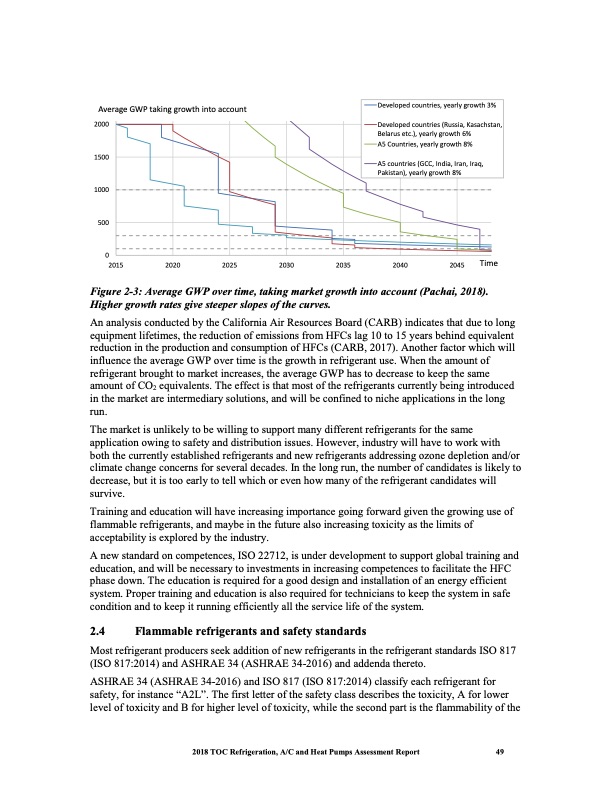
PDF Publication Title:
Text from PDF Page: 062
Average GWP taking growth into account 2000 1500 1000 500 0 2015 2020 2025 2030 2035 2040 2045 Time Developed countries, yearly growth 3% Developed countries (Russia, Kasachstan, Belarus etc.), yearly growth 6% A5 Countries, yearly growth 8% A5 countries (GCC, India, Iran, Iraq, Pakistan), yearly growth 8% Figure 2-3: Average GWP over time, taking market growth into account (Pachai, 2018). Higher growth rates give steeper slopes of the curves. An analysis conducted by the California Air Resources Board (CARB) indicates that due to long equipment lifetimes, the reduction of emissions from HFCs lag 10 to 15 years behind equivalent reduction in the production and consumption of HFCs (CARB, 2017). Another factor which will influence the average GWP over time is the growth in refrigerant use. When the amount of refrigerant brought to market increases, the average GWP has to decrease to keep the same amount of CO2 equivalents. The effect is that most of the refrigerants currently being introduced in the market are intermediary solutions, and will be confined to niche applications in the long run. The market is unlikely to be willing to support many different refrigerants for the same application owing to safety and distribution issues. However, industry will have to work with both the currently established refrigerants and new refrigerants addressing ozone depletion and/or climate change concerns for several decades. In the long run, the number of candidates is likely to decrease, but it is too early to tell which or even how many of the refrigerant candidates will survive. Training and education will have increasing importance going forward given the growing use of flammable refrigerants, and maybe in the future also increasing toxicity as the limits of acceptability is explored by the industry. A new standard on competences, ISO 22712, is under development to support global training and education, and will be necessary to investments in increasing competences to facilitate the HFC phase down. The education is required for a good design and installation of an energy efficient system. Proper training and education is also required for technicians to keep the system in safe condition and to keep it running efficiently all the service life of the system. 2.4 Flammable refrigerants and safety standards Most refrigerant producers seek addition of new refrigerants in the refrigerant standards ISO 817 (ISO 817:2014) and ASHRAE 34 (ASHRAE 34-2016) and addenda thereto. ASHRAE 34 (ASHRAE 34-2016) and ISO 817 (ISO 817:2014) classify each refrigerant for safety, for instance “A2L”. The first letter of the safety class describes the toxicity, A for lower level of toxicity and B for higher level of toxicity, while the second part is the flammability of the 2018 TOC Refrigeration, A/C and Heat Pumps Assessment Report 49PDF Image | Heat Pumps Technical Options

PDF Search Title:
Heat Pumps Technical OptionsOriginal File Name Searched:
RTOC-assessment-report-2018_0.pdfDIY PDF Search: Google It | Yahoo | Bing
CO2 Organic Rankine Cycle Experimenter Platform The supercritical CO2 phase change system is both a heat pump and organic rankine cycle which can be used for those purposes and as a supercritical extractor for advanced subcritical and supercritical extraction technology. Uses include producing nanoparticles, precious metal CO2 extraction, lithium battery recycling, and other applications... More Info
Heat Pumps CO2 ORC Heat Pump System Platform More Info
| CONTACT TEL: 608-238-6001 Email: greg@infinityturbine.com | RSS | AMP |